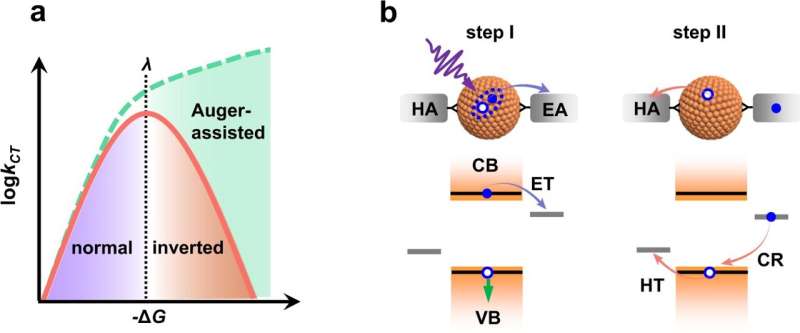Researchers observe Marcus inverted region of charge transfer from low-dimensional semiconductor materials

Charge transfer is a key step in photosynthesis, biological signal transduction, and conversion of various energy sources. The theoretical framework for charge transfer was established by Rudolph Marcus in the 1950s. It predicts the existence of a so-called "Marcus inverted region," where the transfer rate decreases with increasing reaction exothermicity (or driving force).
Low-dimensional semiconductor materials are attracting enormous attention because of their strong potential for optoelectronic and energy-related applications. To date, however, it remains unclear whether Marcus theory is applicable to the charge transfer behavior of these materials.
Recently, a research group led by Prof. Wu Kaifeng from the Dalian Institute of Chemical Physics (DICP) of the Chinese Academy of Science (CAS) observed the Marcus inverted region of charge transfer from low-dimensional semiconductor materials.
This study was published in Nature Communications on Nov. 3.
The researchers built a unique model system using zero-dimensional quantum dots or two-dimensional nanoplatelets and surface-adsorbed molecules that allows for measuring charge transfer from transiently-populated, single-charge states.
Combined with the capability of tuning the electron transfer driving forces through the quantum confinement effect, this measurement allowed to probe the fundamental energetics dependence of electron transfer, and to reveal a Marcus inverted region for these low-dimensional semiconductor materials.
"This is the first observation of a Marcus inverted region for low-dimensional semiconductor materials," said Prof. Wu. "It may benefit energy conversion applications of these materials."
More information: Junhui Wang et al, Marcus inverted region of charge transfer from low-dimensional semiconductor materials, Nature Communications (2021). DOI: 10.1038/s41467-021-26705-x
Journal information: Nature Communications
Provided by Chinese Academy of Sciences




















